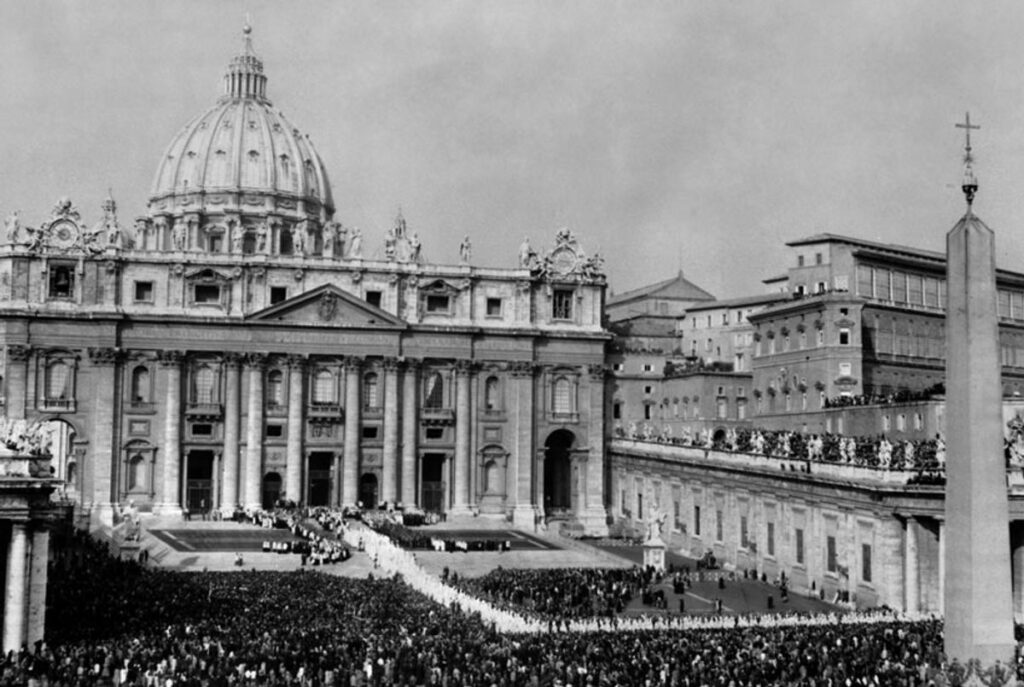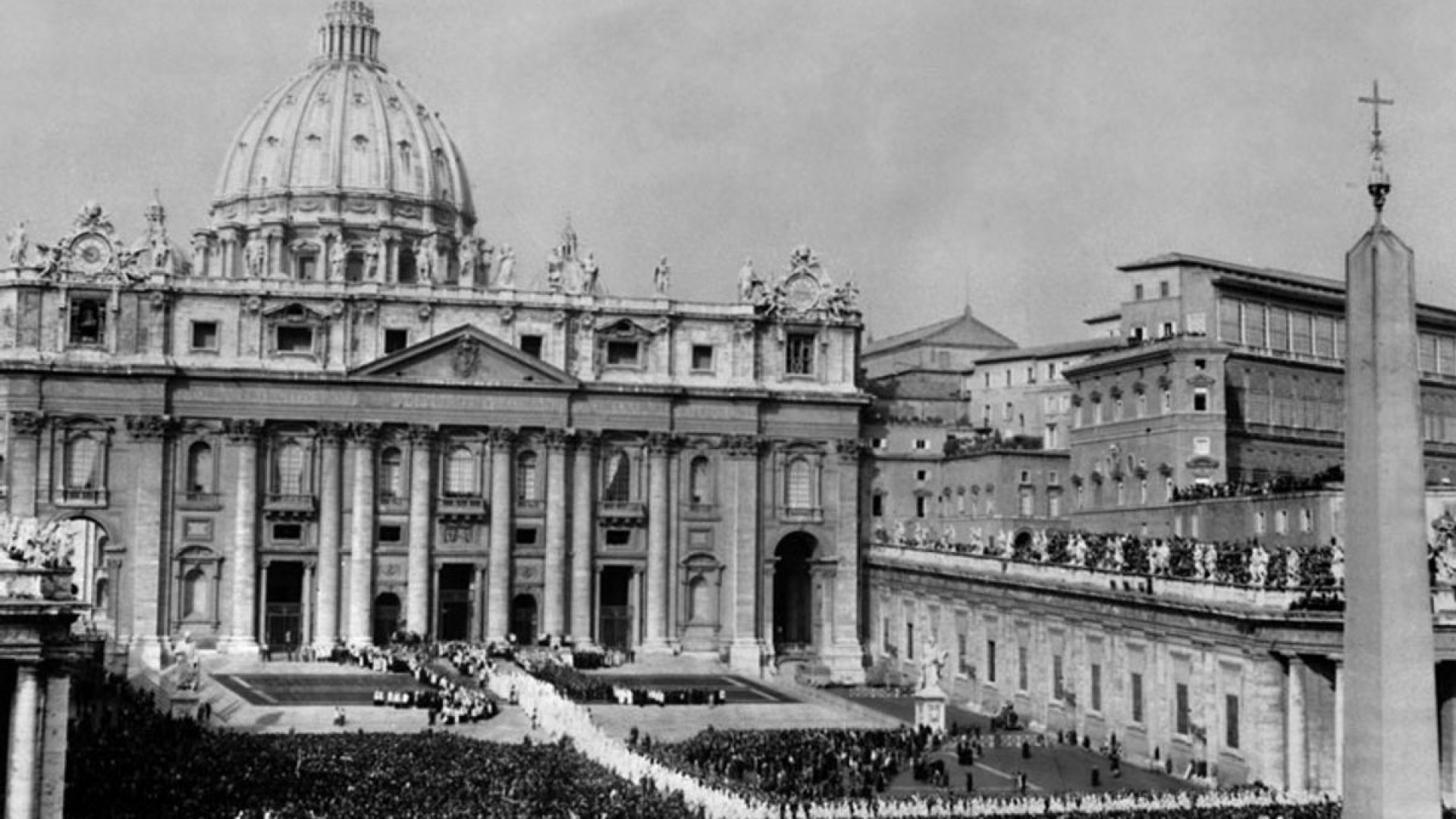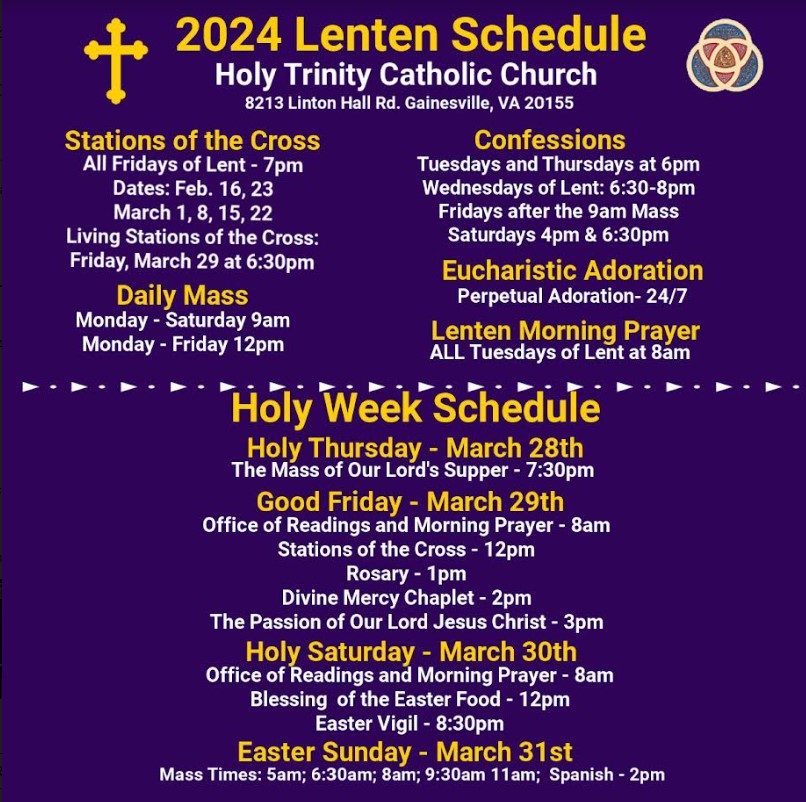I hope the series on the Mass has been helpful. This week we dovetail into a related topic, the Second Vatican Council. (I say ‘dovetail’ as many liturgical changes took place in the Roman Rite after Vatican Council II. We will look at what Vatican Council II actually said.)
October 11, 2022 was the 60th anniversary of the beginning of the Second Vatican Council. St. John XXIII called the council. It began on October 11, 1962 (in the midst of the Cuban Missile Crisis) and ended on December 8, 1965.
Why was Vatican Council II called? Was there a need for it?
We should look at Vatican Council I (VC I) for our answer. VC I occurred from 1869-1870. In preparation for VC I there were close to 50 constitutions prepared for the 774 bishops to consider. The bishops only issued two decrees, one on faith and one on the infallibility of the Pope. Much more work was planned to be done on legal, disciplinary and religious topics. The work never was done.
In the midst of VC I, French troops protected the Vatican and the Papal States (Pope’s territory in central, modern-day Italy) from the military forces attempting to unite all of Italy. The French troops were recalled when the Franco-Prussian War broke out. Italian unification forces attacked and took Rome. Some Swiss Guards died defending Pope Pius IX, who was almost killed. As a result, VC I was suddenly suspended, never to complete its body of work.
Pope Pius XI (1922-1939) and Pope Pius XII (1939-1958) both considered calling an ecumenical council. Pope John XXIII called and opened the council. Pope St. Paul VI closed the council – Pope John died in 1963.
Prior to Vatican Council II (VC II), the last completed ecumenical council was the Council of Trent (1545-1563 in three sessions). The Fifth Lateran Council (1512-1517) preceded Trent. The 400 year span between Trent and VC II is the longest between any two completed councils. What were a few of the changes in the world?
· All ruling Catholic monarchs were gone, i.e. Spain, France, Holy Roman Empire.
· Atheistic communism ruled all of Eastern Europe and much of Asia.
· The Americas had been discovered bringing many conversions to Catholicism – practically all of Central and South America.
· Much of Northern Europe as well as North America was Protestant (controlled). (Recall, the original Protestants broke from the Church in the 1520s and 1530s. There were well over 10,000 Protestant denominations worldwide by 1960.)
· Many Catholic missionaries were active in Africa with many conversions.
If we factor changes in communication, technology, economics, politics and warfare, there was definitely a need for a council! Suffice it to say, Pope John XXIII’s opening remarks as to the purpose of the Second Vatican Council can be summarized in his sentence: The greatest concern of the Ecumenical Council is this: that the sacred deposit of Christian doctrine should be guarded and taught more efficaciously.
God bless
FRVW

Espero que la serie acerca de la Misa haya sido de gran ayuda. Esta semana vamos a encajar un tema relacionado, El Segundo Concilio Vaticano. (Digo ‘encajar’, porque muchos de los cambios litúrgicos tuvieron lugar después del Segundo Concilio Vaticano. Veremos lo que realmente dijo el Segundo Concilio Vaticano).
¿Por qué fue llamado el Segundo Concilio Vaticano? ¿Había necesidad de llamarlo?
Deberíamos ver al Primer Concilio Vaticano (CV I) para nuestra respuesta. CV I ocurrió de 1869-1870. En preparación del CV I hubo cerca de 50 constituciones preparadas para ser consideradas por 774 obispos. Los Obispos emitieron solamente dos decretos, uno sobre la fe y uno sobre la infalibilidad del Papa. Se había planificado mucho más trabajo acerca de cuestiones legales, disciplinarias y religiosas. El trabajo nunca se hizo.
En medio del CV I, las tropas francesas protegieron el Vaticano y los estados papales (el territorio del Papa en Italia del centro y actual Italia) de las fuerzas militares que intentaban unir a toda Italia. Las tropas francesas fueron retiradas cuando estalló la Guerra Franco-prusiana. Las fuerzas unificadoras italianas atacaron y tomaron Roma. Algunos Guardias Suizos murieron defendiendo al Papa Pío IX, quien casi fue asesinado. Como resultado, CV I fue súbitamente suspendido, para nunca completar su cuerpo de trabajo.
Ambos, el Papa Pío XI (1922-1939) y el Papa Pío XII (1939-1958), consideraron llamar a un concilio ecuménico. El Papa Juan XXIII llamó y abrió el concilio. El Papa San Pablo VI cerró el concilio – el Papa Juan XXIII murió en 1963.
Antes del Segundo Concilio Vaticano (CV II), el último concilio ecuménico completado fue el Concilio de Trento (1545-1563 en tres sesiones). El Quinto Concilio de Letrán (1512-1517) precedió al de Trento. El lapso de 400 años entre Trento y CV II es el más largo entre dos concilios completados. ¿Cuáles fueron algunos de los cambios en el mundo?
· Todos los monarcas católicos gobernantes se habían ido, por ej. en España, Francia, el Sacro Imperio Romano.
· El comunismo ateo gobernó toda Europa del Este y gran parte de Asia.
· América había sido descubierta trayendo muchas conversiones al catolicismo – prácticamente toda América del Centro y del Sur.
· Gran parte del Norte de Europa así como Norteamérica era protestante (controlada). (Recuerden, los protestantes originales se separaron de la Iglesia en las décadas de 1520 y 1530. Para 1960 había más de 10,000 denominaciones protestantes en el mundo).
· Muchos católicos misioneros estaban activos con muchas conversiones en África.
Si tomamos en cuenta los cambios en la comunicación, la tecnología, economía, política y la guerra, ¡definitivamente había necesidad de un concilio! Basta decir que las observaciones del Papa Juan XXIII sobre el propósito del Concilio Vaticano II se pueden resumir en su frase: La mayor preocupación del Concilio Ecuménico es esta: que el sagrado depósito de la doctrina cristiana debe ser custodiado y enseñado más eficazmente.
Dios los bendiga
FRVW



